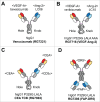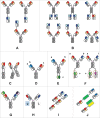The use of CrossMAb technology for the generation of bi- and multispecific antibodies
- PMID: 27285945
- PMCID: PMC4968094
- DOI: 10.1080/19420862.2016.1197457
The use of CrossMAb technology for the generation of bi- and multispecific antibodies
Erratum in
-
Correction.MAbs. 2019 Jan;11(1):217. doi: 10.1080/19420862.2018.1546991. Epub 2018 Nov 13. MAbs. 2019. PMID: 30422058 Free PMC article. No abstract available.
Abstract
The major challenge in the generation of bispecific IgG antibodies is enforcement of the correct heavy and light chain association. The correct association of generic light chains can be enabled using immunoglobulin domain crossover, known as CrossMAb technology, which can be combined with approaches enabling correct heavy chain association such as knobs-into-holes (KiH) technology or electrostatic steering. Since its development, this technology has proven to be very versatile, allowing the generation of various bispecific antibody formats, not only heterodimeric/asymmetric bivalent 1+1 CrossMAbs, but also tri- (2+1), tetravalent (2+2) bispecific and multispecific antibodies. Numerous CrossMAbs have been evaluated in preclinical studies, and, so far, 4 different tailor-made bispecific antibodies based on the CrossMAb technology have entered clinical studies. Here, we review the properties and activities of bispecific CrossMAbs and give an overview of the variety of CrossMAb-enabled antibody formats that differ from heterodimeric 1+1 bispecific IgG antibodies.
Keywords: 2+1, 1+1; 2+2; Ang-2; CEA TCB; CrossMAb; DAF-CrossMAb; DVD-CrossMAb; DuoMAb; EGFR; HER1; HER3; Immunoglobulin domain crossover; Kappa-Lambda-CrossMAb; MoAb; MoAb-Dimer; MonoMAb; P329G LALA; RG7221; RG7386; RG7716; RG7802; Triple A; VEGF-A; asymmetric; heterodimeric; knobs-into-holes (KiH); vanucizumab.
Figures




Similar articles
-
Engineering therapeutic bispecific antibodies using CrossMab technology.Methods. 2019 Feb 1;154:21-31. doi: 10.1016/j.ymeth.2018.11.008. Epub 2018 Nov 16. Methods. 2019. PMID: 30453028 Review.
-
Ten years in the making: application of CrossMab technology for the development of therapeutic bispecific antibodies and antibody fusion proteins.MAbs. 2021 Jan-Dec;13(1):1967714. doi: 10.1080/19420862.2021.1967714. MAbs. 2021. PMID: 34491877 Free PMC article. Review.
-
Progress in overcoming the chain association issue in bispecific heterodimeric IgG antibodies.MAbs. 2012 Nov-Dec;4(6):653-63. doi: 10.4161/mabs.21379. Epub 2012 Aug 27. MAbs. 2012. PMID: 22925968 Free PMC article. Review.
-
"BIClonals": Production of Bispecific Antibodies in IgG Format in Transiently Transfected Mammalian Cells.Methods Mol Biol. 2019;1904:431-454. doi: 10.1007/978-1-4939-8958-4_22. Methods Mol Biol. 2019. PMID: 30539485
-
Immunoglobulin domain crossover as a generic approach for the production of bispecific IgG antibodies.Proc Natl Acad Sci U S A. 2011 Jul 5;108(27):11187-92. doi: 10.1073/pnas.1019002108. Epub 2011 Jun 20. Proc Natl Acad Sci U S A. 2011. PMID: 21690412 Free PMC article.
Cited by
-
Bioprocess Development and Characterization of a 13C-Labeled Hybrid Bispecific Antibody Produced in Escherichia coli.Antibodies (Basel). 2023 Feb 14;12(1):16. doi: 10.3390/antib12010016. Antibodies (Basel). 2023. PMID: 36810521 Free PMC article.
-
Exosome-based strategies for diagnosis and therapy of glioma cancer.Cancer Cell Int. 2022 Aug 21;22(1):262. doi: 10.1186/s12935-022-02642-7. Cancer Cell Int. 2022. PMID: 35989351 Free PMC article. Review.
-
JAK and mTOR inhibitors prevent cytokine release while retaining T cell bispecific antibody in vivo efficacy.J Immunother Cancer. 2022 Jan;10(1):e003766. doi: 10.1136/jitc-2021-003766. J Immunother Cancer. 2022. PMID: 35064010 Free PMC article.
-
TriTECM: A tetrafunctional T-cell engaging antibody with built-in risk mitigation of cytokine release syndrome.Front Immunol. 2022 Nov 10;13:1051875. doi: 10.3389/fimmu.2022.1051875. eCollection 2022. Front Immunol. 2022. PMID: 36439165 Free PMC article.
-
Phenotypic analysis of the unstimulated in vivo HIV CD4 T cell reservoir.Elife. 2020 Sep 29;9:e60933. doi: 10.7554/eLife.60933. Elife. 2020. PMID: 32990219 Free PMC article.
References
-
- Schaefer W, Volger HR, Lorenz S, Imhof-Jung S, Regula JT, Klein C, Molhoj M. Heavy and light chain pairing of bivalent quadroma and knobs-into-holes antibodies analyzed by uhr-esi-qtof mass spectrometry. MAbs 2016; 8(1):49-55; PMID:26496506; http://dx.doi.org/10.1080/19420862.2015.1111498 - DOI - PMC - PubMed
-
- Klein C, Sustmann C, Thomas M, Stubenrauch K, Croasdale R, Schanzer J, Brinkmann U, Kettenberger H, Regula JT, Schaefer W. Progress in overcoming the chain association issue in bispecific heterodimeric igg antibodies. MAbs 2012; 4(6):653-63; PMID:22925968; http://dx.doi.org/10.4161/mabs.21379 - DOI - PMC - PubMed
-
- Merchant AM, Zhu Z, Yuan JQ, Goddard A, Adams CW, Presta LG, Carter P. An efficient route to human bispecific igg. Nat Biotechnol 1998; 16(7):677-81; PMID:9661204; http://dx.doi.org/10.1038/nbt0798-677 - DOI - PubMed
-
- Schaefer W, Regula JT, Bahner M, Schanzer J, Croasdale R, Durr H, Gassner C, Georges G, Kettenberger H, Imhof-Jung S, et al.. Immunoglobulin domain crossover as a generic approach for the production of bispecific igg antibodies. Proc Natl Acad Sci U S A 2011; 108(27):11187-92; PMID:21690412; http://dx.doi.org/10.1073/pnas.1019002108 - DOI - PMC - PubMed
-
- Dengl S, Wehmer M, Hesse F, Lipsmeier F, Popp O, Lang K. Aggregation and chemical modification of monoclonal antibodies under upstream processing conditions. Pharm Res 2013; 30(5):1380-99; PMID:23322133; http://dx.doi.org/10.1007/s11095-013-0977-8 - DOI - PubMed
Publication types
MeSH terms
Substances
LinkOut - more resources
Full Text Sources
Other Literature Sources
Research Materials
Miscellaneous
